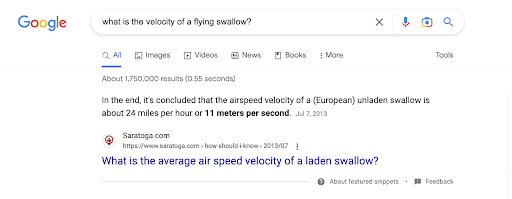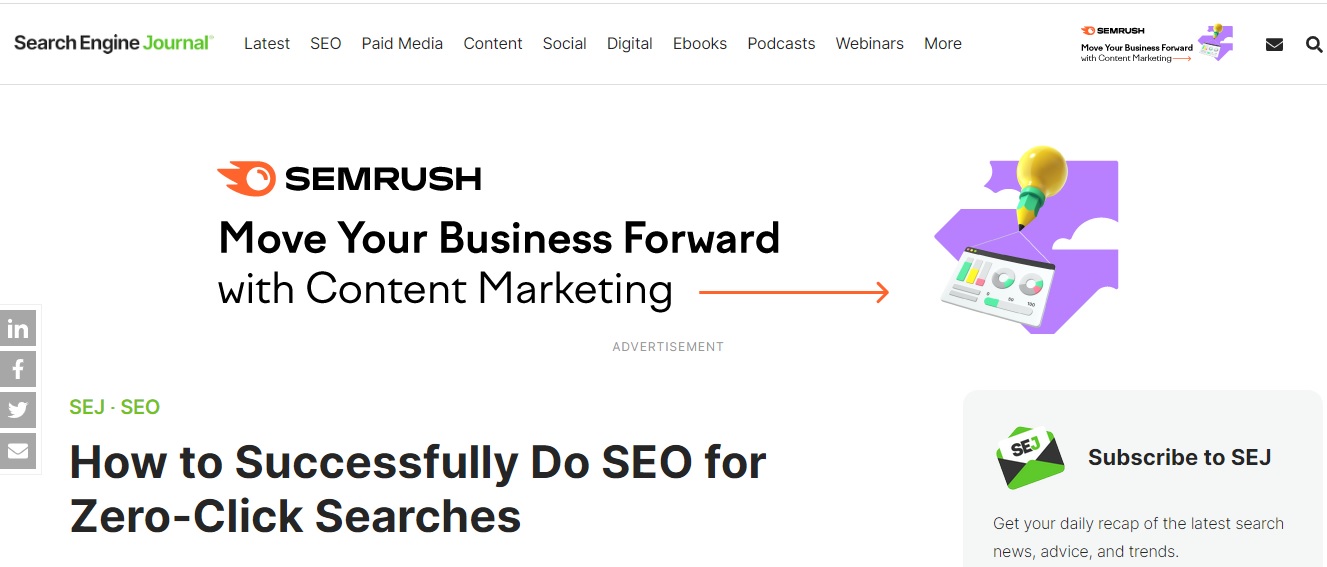Introduction
Zero-click searches are pretty easily summarized: they’re meta-searches.
Knowing that the average attention span of a given internet user is around eight seconds, Google devised a strategy to get consumers the information they needed right away that also helped businesses disseminate that information quickly for their benefit. The result? A quick summary of the search query without having to click on the link that the search yields. The search must be for a quick fact or piece of data, but the convenience is still clearly evident.
Let’s give an example. Say you wanted to find out what the velocity of a flying swallow was. You would type in the search query, “What is the velocity of a flying swallow?” The zero-click search you would yield would be the following:

Pretty convenient, eh? Results like recipes and statistics are among the most common zero-click search topics.

The rising trend of the zero-click search has been quite monumental. One Semrush study showed that close to 57% of mobile users and 53% of desktop users didn’t actually click on an ad or link to a specific business. While marketers initially feared this trend for obvious reasons, hope has settled in: it’s just a different world to navigate, but it is navigable with the right tools and approaches.
The Rise of the Zero-Click Search
Understanding the Zero-Click Search
Now that we have a broadly contextualized definition of the zero-click search, it will be essential to investigate the causes behind its rising trend among consumers. These include Google SERP (search engine results page) features like Direct Answers or Knowledge Panel. The availability of instantaneous information may be useful in one sense, but such instantaneity might hinder the organic procurement of in-depth knowledge about a topic. Plus, how can you be sure that a Google Direct Answer is correct? The vetting process is essential. No value judgments here, just an objective observation of the facts.
The reason that zero-click searches are on the rise is due to the advent of new search engine features (SERP features) that make it easier to find information fast, capitalizing on users’ increasingly shortened attention spans. Kind of spooky but true.
Optimizing for Zero-Click Searches

So what are the implications of such SERP features for content creators? Knowing that clickthrough rates (CTRs) for an organic search result are inversely correlated with the rise of zero-click searches, content creators must think outside the box for SEO strategies for their brands. Different tactics, folks! SEO goals, to occupy top positions and ranking real estate for user searches, remain by and large the same. To adapt, optimize for a featured snippet! It’s pretty simple in theory, but SERP-specific tools like increasing search presence and emphasizing brand awareness right from the get-go will help. You’ll still want to monitor clickthrough rates, but you’ll also want to see how your SERP strategies for immediate prominence of preliminary search results compare to such clickthrough rates.
Another SERP strategy you can use as your company’s content marketer is optimizing for voice search. Studying user behavior with tools like Google Home Search, Siri, and Alexa can yield interesting and fruitful data for you to play with.
Lastly, utilizing structured data as an SEO strategy is key. This is also known as adding schema markup, which is adding code on your website that uses Google search engine tools to analyze, understand, and categorize your website content. Adding schema markup could increase your rankings.

Measuring Zero-Click Search Success
The primary way you can measure zero-click search success is by the before-and-after strategy-and-results plan that you use.
For instance, if you’ve improved page navigation for your users, study how much traffic gets directed to your site through zero-click searches. Adding metadata such as alt text will help search engines correctly identify your page’s contents. One prominent way to measure success is by integrating with Google My Business and measuring website traffic to your business through zero-click searches.
The conventional ways also apply: use analytics tools, track search engine rankings, and analyze user feedback.
Conclusion
The results are in: zero-click searches are on the rise. The good news is that there is something (“somethings”) you can do about this trend.
Knowledge is power, so knowing about the rise of zero-click searches is the first step in gleaning insight into optimizing your business to adapt to these internet changes. Short bytes of data are in with an average internet user’s attention span of eight seconds. That doesn’t mean you should contribute to memory loss – for obvious reasons – but to ride the wave, make it easier for people to find your site. That general rule is pretty simple.
One way that we haven’t mentioned so far is through being more accessible on mobile devices. Given the statistic we presented about how many users aren’t clicking organic links on their mobile devices, get integrated with mobile features!
Optimizing your content marketing efforts for the zero-click search is such a necessary process these days. You can do so through featured snippets and integrating with both voice and mobile searches.
FAQs
1. What is the zero-click search?
The zero-click search is a meta-search. It enables users to find critical pieces of information for facts and figures, concrete ideas and processes, and locations/directions without having to click on organic links as a result of their searches. They take the form of featured snippets and displays of quick “bytes” of data.
2. Why are zero-click searches on the rise?
Shortened attention spans and the advent of new SERP features like Google’s Direct Answers are the primary causes for this trend.
3. How can I optimize my content for zero-click searches?
Integrating with mobile and voice searches, emphasizing brand awareness through advertising content that can quickly display, capture, and encapsulate your digital content, and including schema markup are all ways to optimize your content marketing for zero-click searches.
4. How can I measure the results of my zero-click search efforts?
You can do this by before-and-after analyses of the SEO strategy features you’ve integrated for zero-click searches. After optimizing for voice and mobile integration, study the traffic directed to your website. After integrating with Google My Business, again, measure traffic. You should also use analytics tools, track search engine rankings, and analyze user feedback.
5.What are the best practices for the zero-click search?
Creating a zero-click search content strategy, building a strong mobile presence, and utilizing schema markup are all best practices for this purpose.


